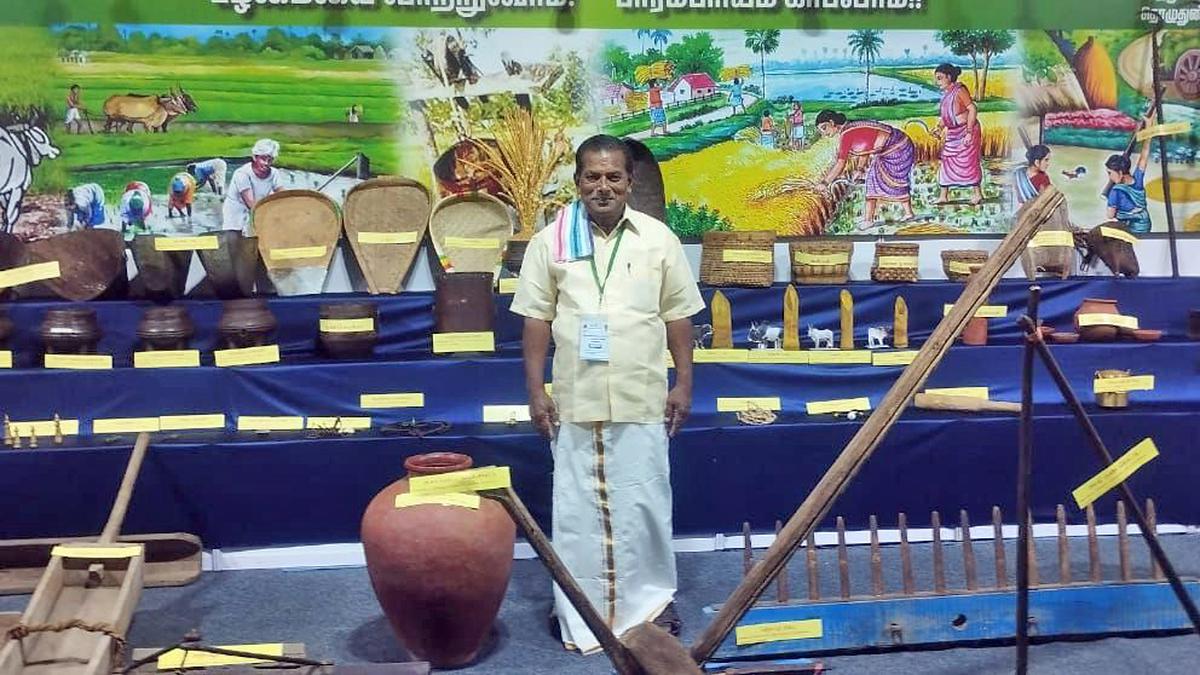
Preserving traditional agricultural tools elbowed out by mechanisation Premium
The Hindu
Preserving traditional agricultural tools elbowed out by mechanisation
P. Chenbagasekara Pillai, of Thuvarangadu, a fertile village in the northern part of Kanniyakumari, has a unique passion for agricultural tools. He has collected over 80 storage structures, sickles, Sulakus (fans) for winnowing and other tools that have become redundant with the mechanisation of agriculture following the Green Revolution. These implements were an integral part of manual labour and use of cattle. As agriculture is his family vocation, he retained the tools used by his forefathers and collected from others who no longer used them.
Though Thuvarangadu is a typical Nanjil Nadu village, surrounded by paddy fields and banana and coconut groves, gone are the days when the daily schedule of a farmer would start in the early hours of a day. From cleaning the cattle shed; feeding cows; milking them; taking bulls and buffaloes to field for ploughing and levelling; bathing them in local tanks or rivers; shifting the organic manure collected in the backyard of the house to the field in a bullock cart; harvesting the crops and bringing them home for threshing and winnowing; and finally keeping them in storage structures called Pathayam or Kuthir, the life of a farmer was intertwined with agriculture till some years ago. Now, the backyards or Kalams used for winnowing are either covered with concrete or built over. Immediately after the harvest, the produce is sold to farmers in the field itself. Today, nothing comes to the house of the farmer, even the haystack as very few keep cattle and buy milk in plastic pockets.
“I started collecting the implements from the 1980s as I wanted to preserve them for the posterity,” says Mr. Pillai, whose old Nanjil Naatu style house with a front courtyard (Muttram) continues to stand amid concrete houses at Thuvarangadu. He is so popular that the Government Agriculture College at Kallikulam in Tirunelveli and the Agriculture College and Research Institute in Madurai send their students to intern with him for a month to learn the old practices of agriculture.
Among his collection is Ooni, which has disappeared from the collective memory of everyone. It is a tool used for irrigating the field. “My father used to measure the water in terms of Ooni and would always ask how many Ooni had flown into the field,” he recalled. There is also Eraivatti for draining water; Paathala Karanti (a bunch of hooks) for fishing out objects from the well; Pillai Kampu that was used to hold cradles for the babies of women working the field; Kottams for giving medicine to cattle depending on their weight; and bells for decorating them.
Mr. Pillai, a graduate who worked for a brief period outside before returning to take up agriculture full time, said farmers adopted time-tested methods. “They used specific woods for making agricultural tools. Three different types of woods — teak, Pinnai (Alexandrian Laurel) and Vagai (rain tree) — were used for making different parts of a plough. The rope for tying them together was made of buffalo hide.”
The leveller, made from the rain tree (because the wood is heavy), was normally used when farmers opted for dry sowing. The levelling of the ground for wet sowing would be done by the implement made from Ilavam (sliver cotton tree), known for its water-resistance.
“Farmers in the northern part of Kanniyakumari use the wood of Unnu for making the handles for spades as the plant is available in plenty in the nearby forests. Unnu finds reference in the Sangam literature. In some parts, the wood of guava trees is used. The advantage with Unnu is that it will not hurt the hands of farmers,” he said. The wood of Maavilangu was preferred for making the handle of the sickle for cutting grass.











